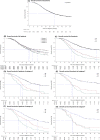International Retrospective Cohort Study of Conversion Therapy for Stage IV Gastric Cancer 1 (CONVO-GC-1)
- PMID: 35261948
- PMCID: PMC8889854
- DOI: 10.1002/ags3.12515
International Retrospective Cohort Study of Conversion Therapy for Stage IV Gastric Cancer 1 (CONVO-GC-1)
Abstract
Aim: Much attention has been paid to conversion therapy for stage IV gastric cancer, however, its operative comorbidities and survival benefit have not yet been clarified. CONVO-GC-1, an international retrospective cohort study, was designed to investigate the role of conversion surgery in Japan, Korea, and China.
Methods: The rate of operative complications was the primary endpoint and the overall survival (OS), according to the four-category criteria previously published (Gastric Cancer:19; 2016), was analyzed as the secondary endpoint.
Results: A total of 1206 patients underwent surgery after chemotherapy with curative intent. Operative complications were observed in 290 (24.0%) patients in all grades, including pancreatic fistula and surgical site infection. The median survival time (MST) of all resected patients was 36.7 mo (M) and those of R0, R1, and R2 resection were 56.6 M, 25.8 M, and 21.7 M, respectively. Moreover, the MST of R0 patients were 47.8 M, 116.7 M, 44.8 M in categories 1, 2, and 3, respectively, and not reached in category 4. Interestingly, the MST of P1 patients was as favorable as that of P0CY1 patients if R0 resection was achieved. The MST of patients with liver metastasis was also favorable regardless of the number of lesions, and the MST of patients with para-aortic lymph node (LN) No 16a1/b2 metastasis was not inferior to that of patients with para-aortic LN No 16a2/b1 metastasis.
Conclusion: Conversion therapy for stage IV gastric cancer is safe and could be a new therapeutic strategy to improve the survival of patients, especially those with R0 resection.
Keywords: adjuvant surgery; chemotherapy; conversion therapy; gastric cancer; metastatic gastric cancer.
© 2021 The Authors. Annals of Gastroenterological Surgery published by John Wiley & Sons Australia, Ltd on behalf of The Japanese Society of Gastroenterology.
Figures



References
-
- GLOBOCAN2018 . CANCER FACT SHEETS. [updated 2018; cited 18 Oct 2020]. Available from: https://gco.iarc.fr/today/data/factsheets/populations/900‐world‐fact‐she...
-
- Sobin LGM, Wittekind C. TNM classification of malignant tumours, 7th edn. Hoboken: Wiley‐Blackwell; 2009.
-
- Amin MB, Edge S, Greene F, et al. AJCC cancer staging manual, 8th edn. New York: Springer; 2017.
-
- Japanese Gastric Cancer Association . Japanese classification of gastric carcinoma. Gastric Cancer. 2011;15(14):101–12. - PubMed
-
- Japanese Gastric Cancer Association . Japanese gastric cancer treatment guidelines 2010 (ver. 3). Gastric Cancer. 2011;14:113‐23. - PubMed
LinkOut - more resources
Full Text Sources
Miscellaneous

